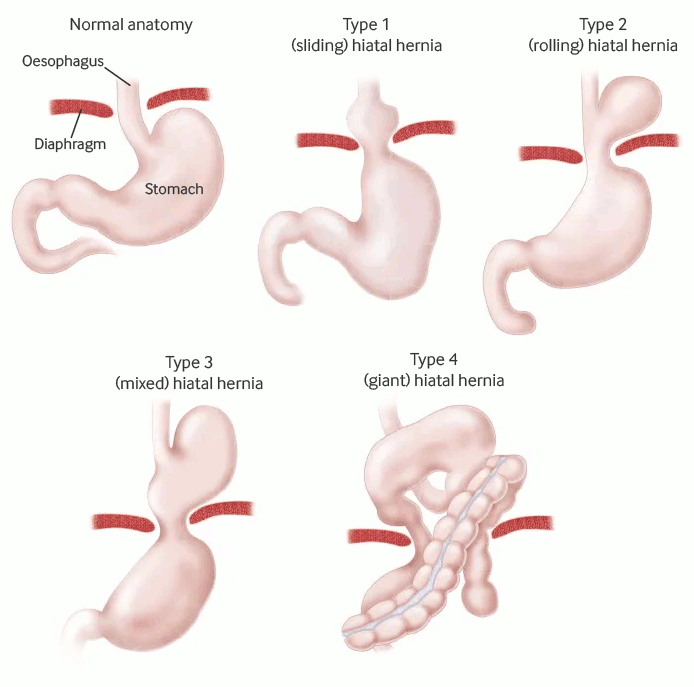Aetiology
A clear aetiology for hiatus hernia is not known; aetiology is probably multi-factorial.[7][8][9]
During normal swallowing, the oesophagus shortens several centimetres due to contraction of its longitudinal muscular layer. This action, in combination with elevations in intra-abdominal pressure such as from coughing, sneezing, straining, and strenuous exercise, produces physiological movement of the distal oesophagus and possibly the gastro-oesophageal junction through the oesophageal hiatus and into the posterior mediastinum. This movement is countered by the resistance of the phreno-oesophageal ligaments, which run between the diaphragm and the gastro-oesophageal junction. These ligaments are somewhat elastic in terms of their stretch and recoil.
Eventually the physiological movement and stretching may enlarge the hiatus, leading to permanent residence of a portion of the stomach above the diaphragm.
Pathophysiology
In sliding hiatus hernia (type I), the displacement of the gastro-oesophageal junction above the diaphragm decreases the lower oesophageal sphincter (LOS) pressure.[7][10] Because the LOS is the primary determinant of the anti-reflux valve, a decrease in LOS pressure predisposes the patient to gastro-oesophageal reflux. Thus, the most common symptom of a symptomatic sliding hiatus hernia is reflux-associated heartburn, or pyrosis. It follows that the mainstay of treatment for a symptomatic sliding hiatus hernia is very similar to that for gastro-oesophageal reflux disease.
The situation for the relatively uncommon para-oesophageal hernia (types II-IV) differs because the rotation and twisting of the stomach as it migrates into the chest can produce intermittent strangulation with obstruction and ischaemia. This can result in pain, vomiting, ulcers, and necrosis. Pain from a para-oesophageal hernia can easily be mistaken for angina pectoris. Ischaemic ulcers can produce upper gastrointestinal haemorrhage with haematemesis. Ischaemic necrosis of the stomach is one of the most feared complications of para-oesophageal hernia. Such an event typically progresses rapidly to mediastinitis and death if left untreated.
[Figure caption and citation for the preceding image starts]: Types of hiatal herniaAdapted from “Paraesophageal Hernia Repair". Abdominal Key, 2019; used with permission [Citation ends].
Classification
Types of hiatus hernia[1]
Type I
Sliding hiatus hernia
Protrusion of the gastro-oesophageal junction followed by the body of the stomach through the oesophageal hiatus and above the diaphragm
Most common type.
Type II
Pure para-oesophageal hernia or rolling hiatus hernia
Herniation of the fundus or body of the stomach or both into the chest alongside the oesophagus, with maintenance of the gastro-oesophageal junction in a normal anatomical position below the diaphragm.
Type III
Mixed or combined para-oesophageal hernia
Combination of types I and II. The fundus or body of the stomach or both have herniated into the chest; the gastro-oesophageal junction is also herniated into the chest, but rests below the herniated stomach.
Type IV
Also known as giant hiatus hernia
Occurrence of any type of hiatus hernia along with herniation of one or more other organs, such as colon, small bowel, omentum, and spleen.
[Figure caption and citation for the preceding image starts]: Types of hiatal herniaAdapted from “Paraesophageal Hernia Repair". Abdominal Key, 2019; used with permission [Citation ends].

Use of this content is subject to our disclaimer